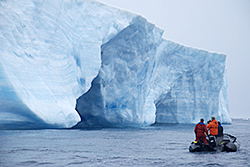You are here
Once-in-a-lifetime Opportunity to Study Environmental Changes in Antarctica
 12/05/11 Portland, Ore.
12/05/11 Portland, Ore.
You will need really warm clothes where this Oregon Health & Science University (OHSU) class is going to be held next December. It is considered one of the coldest, driest, and windiest places on Earth.
The classroom is Antarctica, the most awe-inspiring place you will find to study the health of the environment.
Undergraduate and graduate students will have a rare opportunity to study in Antarctica and gain firsthand knowledge of this globally important ecosystem through the Students on Ice Antarctic University Expedition 2013.
This ship-based expedition is from December 28, 2013 through January 9, 2014 and will include approximately 60 students from around the world and 30 university faculty, scientists, experts, policy makers and educators.
Joseph Needoba, Ph.D., a scientist with the Center for Coastal Margin Observation & Prediction (CMOP) and an assistant professor in Division of Environmental & Biomolecular Systems at OHSU’s Institute of Environmental Health, will be one of those faculty members aboard. He will be teaching a field course on environmental systems and human health.
"This course will examine the biogeochemistry and ecology of Antarctica in the face of environmental change, with an emphasis on planetary boundaries for human well-being," Needoba says.
Needoba is part of a large multi-institutional science team at CMOP that is conducting research on the effects of human activity on our oceans and estuaries including acidification, hypoxia, and harmful plankton blooms. He hopes the expedition will provide students with greater insight into these changes on a global scale.
"We will travel across the Southern Ocean to explore Antarctica and experience firsthand the natural world as it exists with minimal human activity and consider what types of environmental perturbations from human activity can be detected even in this remote region."
Once in Antarctic waters, students make frequent field trips to the Antarctic mainland via Zodiac inflatable boats from the expedition vessel, M/V Ushuaia. These landings will be supplemented by lectures, presentations, seminars and lab exercises in dedicated space aboard the ship.
Undergraduate and graduate students from universities around the world are eligible to apply. Students may choose to register for one of several university courses while they participate in the expedition.
The experience comes with a price. Students must pay the expedition fees and costs of airfare from their home institutions. Students typically seek to offset the cost by a variety of fundraising activities. The Students on Ice program provides a fundraising toolkit to help students raise the money and actively seek sponsorship or funding to be used to lower the student expedition fees.
Over two thousand students from more than 50 countries have participated on Students on Ice expeditions to the Arctic and Antarctic. This year a select group of students will be chosen to participate on the expedition.
If you are one of the lucky students accepted into the program, pack your thermal underwear and get ready for a once-in-a-lifetime experience to study environmental change in the globally important ecosystem called Antarctica.
To learn more about the Students on Ice Antarctic University Expedition 2013, visit the website at www.uantarctic.org or contact Dr. Needoba at needobaj@ohsu.edu.
Written by Jeff Schilling






